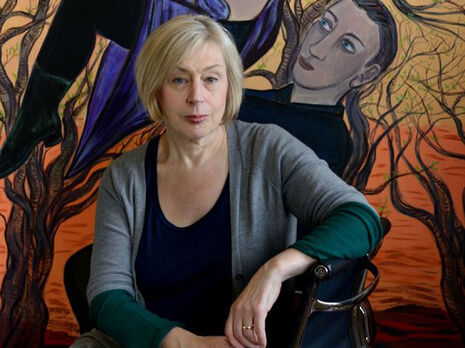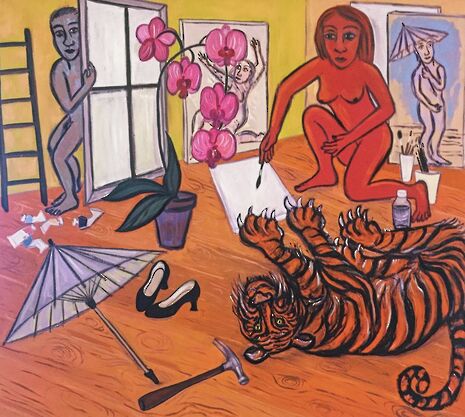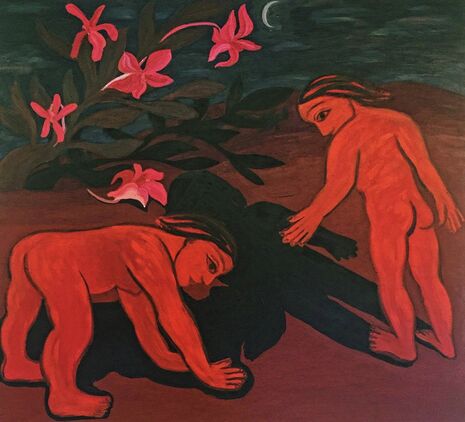Eileen Cooper’s ‘A Woman’s Skin’ at Wolfson
Art historian Samantha Ruston reflects on why we should value Keeper of the Royal Academy Eileen Cooper for more than just her art

After the exhibition opening of ‘A Woman’s Skin’ at Wolfson College, Eileen Cooper gave an interview even more inspiring than her work. Rather than providing revelation about her own art, Cooper provided revelation about what it means to be an artist. When asked “when do you decide to change medium?” Cooper responded, “when I think I am becoming too good.”
“When asked “when do you decide to change medium?” Cooper responded, “when I think I am becoming too good.”
In her art and in her life, Cooper pushes boundaries. She was elected to the Royal Academy in 2001 and became the first female Keeper in 2011. With female artists such as Rachel Whiteread rejecting the Academy, it needed someone (specifically a female), to shake up its outdated and feudal ideals. Cooper remarked that “you can’t change anything if you’re not participating,” adding that the Academy desperately needed renewal. Fellow Royal Academician Anthony Green, two seats behind me, murmured in agreement. Cooper disclosed that she is also stepping down this year in order for this very cycle of regeneration to continue.
As a female artist her work is certainly feminist. Cooper’s art focuses on the (often nude) female body, playing with themes that evoke sexuality, motherhood, and nature: three attributes certainly familiar to the female canon of art.
Cooper deals with feminism in her artwork, but also strives to deal with the inequality and underrepresentation of female artists in a largely male-dominated art world. A few statistics to corroborate this claim are: in 2000, the Guggenheim Gallery (New York) had zero solo shows by women; in 2014, women had 14 percent of solo shows. In the 2015 Venice Biennale, over two-thirds of works were by men. The highest price paid at auction for a living male artist’s work was $58.6 million (Jeff Koon’s Balloon Dog); for a living female artist’s work, $7.1 million (Yayoi Kusama’s White 28). Women also direct less than a quarter of galleries with budgets of over $15 million. Although it would be unfair to say that the art-world has not seen a raised awareness of inequality in recent years, there is still work to be done.
Unless you believe that these statistics are because women produce less good art (and if you share this view, please do not share it with me), there must be another cause. Although other industries certainly face issues of parity, female artists have art history at their elbow. The Guerilla Girls – a group of feminist activist artists – raise an interesting statistic in their 2012 poster: “Do women have to be naked to get into the Met. Museum? Less that 4% of the artists in the Modern Art sections are women, but 76% of the nudes are female.” You don’t have to be an art historian (although it just so happens that I am) to know that art has been dominated by the male canon since its beginning. In Vasari’s seminal text Lives of the Artists, he does not include one female artist. It is not difficult to see why in the context of this tradition: work by female artists is often seen as inferior to that of males. This cycle needs to be broken. A change needs to happen and the change has to start somewhere.

Fundamentally, all else aside, more diversity results in better art. It creates a more interesting dialogue; a more compelling and exciting conversation between art and art history, art and artist, artist and viewer. I found this concept of dialogue particularly interesting on a number of levels. In my degree I encounter discourses between artists, periods and socio-political contexts on a daily basis, but it was enlightening to learn about the conversations between an artist’s own works. Cooper explained how these connections happen on both a conscious and subconscious level as she worked on a number of paintings simultaneously. She also spoke about the importance of the viewer and their own personal interpretations.
At the exhibition, I reflected on two collages and their meaning. In the first, the female figure is in full view; in the second, she is hidden. I concluded that it was about exposure and the body. Cooper later revealed that the figure is only hidden because she messed up the print. Despite this, she assured the audience that the viewer is always “the last piece of the jigsaw puzzle,” quoting British artist, Matthew Higgs.
Cooper’s style is crude. Proportion and perspective is not pertinent. Her brash brushwork and bold colour is quasi-aggressive. The portraits are confrontational; they invade your space. Yet, there is something primitive and childlike in their form; a familiarity. You feel like you know the work or that you’ve seen it before. This probably comes from the fact that all the figures in the works (that span twenty-seven years) appear to be of the same person; perhaps self-portraits of Cooper? (I couldn’t help but notice a strange resemblance). Yet her work is not just personal. Not even personal to women, but universal. Monumental but also relatable; subjective in its objectivity.
Eileen Cooper’s art is certainly worth seeing, but even more so I would argue that she is an artist worth knowing: a rare creature who hales from a bygone art-world, but who has their eyes set firmly on the future

 News / Cambridge academics stand out in King’s 2026 Honours List2 January 2026
News / Cambridge academics stand out in King’s 2026 Honours List2 January 2026 Interviews / You don’t need to peak at Cambridge, says Robin Harding31 December 2025
Interviews / You don’t need to peak at Cambridge, says Robin Harding31 December 2025 Comment / What happened to men at Cambridge?31 December 2025
Comment / What happened to men at Cambridge?31 December 2025 News / Varsity’s biggest stories of 202531 December 2025
News / Varsity’s biggest stories of 202531 December 2025 Features / “It’s a momentary expression of rage”: reforming democracy from Cambridge4 January 2026
Features / “It’s a momentary expression of rage”: reforming democracy from Cambridge4 January 2026









